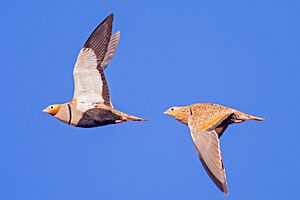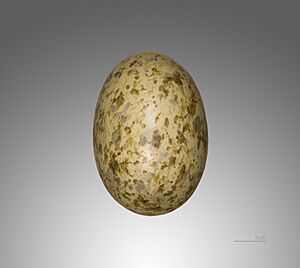Black-bellied sandgrouse facts for kids
Quick facts for kids Black-bellied sandgrouse |
|
|---|---|
 |
|
| Conservation status | |
| Scientific classification | |
| Genus: |
Pterocles
|
| Species: |
orientalis
|
| Synonyms | |
|
Tetrao orientalis Linnaeus, 1758 |
|
The black-bellied sandgrouse (Pterocles orientalis) is a medium-sized bird. It belongs to the sandgrouse family. These birds are known for their unique looks and how they live. They are found in many dry, open areas across Europe, Africa, and Asia.
This bird breeds in places like the Iberian Peninsula, Northwest Africa, and the Canary Islands. You can also find them in Turkey, Iran, Cyprus, and Israel. An eastern type, called P. o. arenarius, lives in Kazakhstan, western China, and northern Pakistan. Some of these birds are migrants. This means they move from central Asia to Pakistan and northern India for the winter.
Contents
What is the Black-bellied Sandgrouse?
The black-bellied sandgrouse was first officially described in 1758. A Swedish scientist named Carl Linnaeus gave it its scientific name. He put it in a group with other grouse-like birds. Its full scientific name is Tetra orientalis.
Today, the black-bellied sandgrouse is part of the Pterocles group. This group has 13 other species. A Dutch scientist, Coenraad Jacob Temminck, created this group in 1815.
Different Types of Black-bellied Sandgrouse
Scientists recognize two main types, or subspecies, of the black-bellied sandgrouse:
- P. o. orientalis (Linnaeus, 1758) – This type lives in the Canary Islands, Iberian Peninsula, Morocco, and west Iran.
- P. o. arenarius (Pallas, 1775) – This type is found from Kazakhstan to southern Iran and Afghanistan, reaching east to northwest China.
How to Spot a Black-bellied Sandgrouse
The black-bellied sandgrouse is about 33–39 cm (13–15 in) long. It weighs between 300–615 g (10.6–21.7 oz). It might be the largest bird in the sandgrouse family.
Male and Female Birds
The male bird has a grey head, neck, and chest. Its belly is black. Its upper parts are golden-brown with darker marks. There is a thin black line around its lower chest. It also has a chestnut-colored patch on its throat.
This sandgrouse has a small head and neck, much like a pigeon. But its body is strong and compact. It has long, pointed wings. It flies very fast and straight. When it flies, you can easily spot its white underwings and black belly. Flocks of these birds often fly to water sources early in the morning.
The female bird has browner upper parts. These parts are also more finely marked. This includes her head and chest. Her belly and chest band look the same as the male's.
The eastern type of sandgrouse is usually paler and heavier. Male birds of this type have yellower upper parts. Their underparts are greyer than the western type. Female birds of the eastern type are whiter underneath. However, it can be hard to tell them apart. Their call sounds like a soft chowrrr rrrr-rrrr.
Where Do Black-bellied Sandgrouse Live?
These birds like to live in groups. They breed in dry, open plains and similar areas. But unlike the pin-tailed sandgrouse, they do not like places with no plants at all.
Their nest is a simple scrape on the ground. They lay three greenish eggs there. These eggs have special markings that help them blend in. Both the male and female birds take turns sitting on the eggs. But only the male brings water back to the nest.
Black-bellied Sandgrouse in Old Stories
The Mughal emperor Babur wrote a memoir in the Chagatai language. It was called Baburnama. In this book, he talked about the Pterocles orientalis arenarius. He called it the qīl-qūyirūgh, which means "horse-tail." He also said it was the "bāghrī qarā" of Transoxiana.



